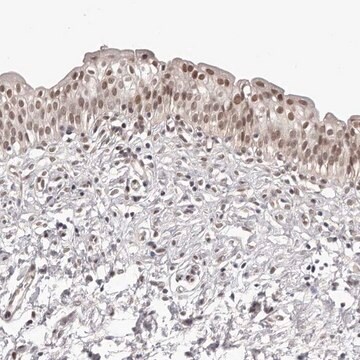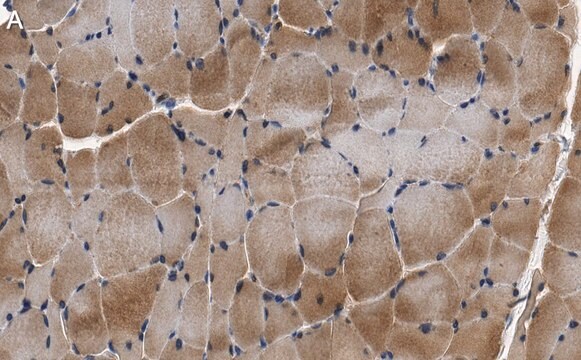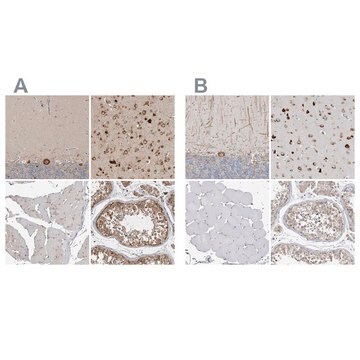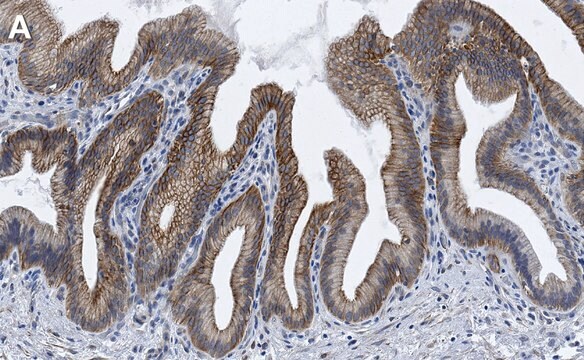일반 설명
We are committed to bringing you greener alternative products, which adhere to one or more of The 12 Principles of Green Chemistry.This antibody is Preservative-free, produced without the harm or sacrifice of animals and exceptionally stable to allow for ambient shipping and storage if needed and thus aligns with "Waste Prevention", "Designing Safer Chemicals" and "Design for Energy Efficiency".
Click here for more information.
ZooMAb® antibodies represent an entirely new generation of recombinant monoclonal antibodies.Each ZooMAb® antibody is manufactured using our proprietary recombinant expression system, purified to homogeneity, and precisely dispensed to produce robust and highly reproducible lot-to-lot consistency. Only top-performing clones are released for use by researchers. Each antibody is validated for high specificity and affinity across multiple applications, including its most commonly used application. ZooMAb® antibodies are reliably available and ready to ship when you need them.
특이성
Clone 3D15 is a ZooMAb® Rabbit recombinant monoclonal antibody that specifically detects Calcium-activated potassium channel subunit alpha-1 (Maxi K/BK channel). It targets an epitope within 19 amino acids from the C-terminal half.
면역원
KLH-conjugated linear peptide corresponding to 19 amino acids from the C-terminal half of human Calcium-activated potassium channel subunit alpha-1 (Maxi K/BK channel).
애플리케이션
Quality Control Testing
Evaluated by Western Blotting in Mouse brain tissue lysate.
Western Blotting Analysis: A 1:10,000 dilution of this antibody detected Maxi K/BK channel in Mouse brain tissue lysate.
Tested applications
Western Blotting Analysis: A 1:10,000 dilution from a representative lot detected Maxi K/BK channel in Human brain and Rat brain tissue lysates.
Immunohistochemistry (Paraffin) Analysis: A 1:1,000 dilution from a representative lot detected Maxi K/BK channel in human cerebellum tissue sections.
Affinity Binding Assay: A representative lot of this antibody bound Maxi K/BK channel peptide with a KD of 1.2 x 10-7 in an affinity binding assay.
Immunocytochemistry Analysis: A 1:100 dilution from a representative lot detected Maxi K/BK channel in A549 and C6 cells.
Note: Actual optimal working dilutions must be determined by end user as specimens, and experimental conditions may vary with the end user
Evaluated by Western Blotting in Mouse brain tissue lysate.
Western Blotting Analysis: A 1:10,000 dilution of this antibody detected Maxi K/BK channel in Mouse brain tissue lysate.
표적 설명
Calcium-activated potassium channel subunit alpha-1 (UniProt: Q12791; also known as BK channel, BKCA alpha, Calcium-activated potassium channel subfamily M subunit alpha-1, K(VCA)alpha, KCa1.1, Maxi K channel, MaxiK, Slo-alpha, Slo1, Slowpoke homolog, Slo homolog, hSlo) is encoded by the KCNMA1 (also known as KCNMA, SLO) gene (Gene ID: 3778) in human. Maxi K is a homotetrameric, multi-pass membrane protein that contains five extracellular domains, seven transmembrane domains (S0-S6), four cytoplasmic domains, and one pore forming region (aa 336-358). With the exception of monocytes, it is widely expressed. It serves as the large-conductance Ca2+- and voltage-activated K+ channel that plays a role in cell signalling by interacting with a multiplicity of proteins at plasma membrane and intracellular organelles including the endoplasmic reticulum, nucleus, and mitochondria. Its structure consists of four -subunits, each formed by 7 transmembrane segments and a large C-terminus that constitutes about two thirds of the protein. The S4 segment (aa 265-285) that contains a series of positively charged amino acids at every third position serves as the voltage-sensor. Maxi K channel plays a key role in controlling excitability in a number of systems, such as regulation of the contraction of smooth muscle, the tuning of hair cells in the cochlea, regulation of transmitter release, and innate immunity. In smooth muscles, its activation by high level of Ca2+, caused by ryanodine receptors in the sarcoplasmic reticulum, regulates the membrane potential. In cochlea cells, its number and kinetic properties partly determine the characteristic frequency of each hair cell and thereby helps to establish a tonotopic map. Maxi K is reported to be highly sensitive to iberiotoxin and charybdotoxin. This ZooMAbZooMAb® recombinant monoclonal antibody, generated by our propriety technology, offers significantly enhanced specificity, affinity, reproducibility, and stability over conventional monoclonals. (Ref.: Toro, L., et al. (2014). Pflugers Arch. 466(5); 875-886).
물리적 형태
Purified recombinant rabbit monoclonal antibody IgG, lyophilized in PBS, 5% Trehalose, normal appearance a coarse or translucent resin. The PBS/trehalose components in the ZooMAb formulation can have the appearance of a semi-solid (bead like gel) after lyophilization. This is a normal phenomenon. Please follow the recommended reconstitution procedure in the data sheet to dissolve the semi-solid, bead-like, gel-appearing material. The resulting antibody solution is completely stable and functional as proven by full functional testing. Contains no biocide or preservatives, such as azide, or any animal by-products. Larger pack sizes provided as multiples of 25 μL.
재구성
300 μg/mL after reconstitution at 25 μL per vial. Please refer to guidance on suggested starting dilutions and/or titers per application and sample type.
저장 및 안정성
Recommend storage of lyophilized product at 2-8°C; Before reconstitution, micro-centrifuge vials briefly to spin down material to bottom of the vial; Reconstitute each vial by adding 25 μL of filtered lab grade water or PBS; Reconstituted antibodies can be stored at 2-8°C, or -20°C for long term storage. Avoid repeated freeze-thaws.
법적 정보
ZooMAb is a registered trademark of Merck KGaA, Darmstadt, Germany
면책조항
Unless otherwise stated in our catalog or other company documentation accompanying the product(s), our products are intended for research use only and are not to be used for any other purpose, which includes but is not limited to, unauthorized commercial uses, in vitro diagnostic uses, ex vivo or in vivo therapeutic uses or any type of consumption or application to humans or animals.









